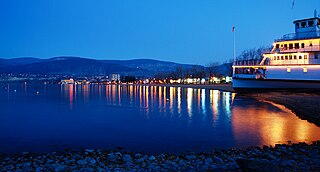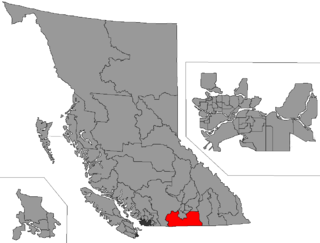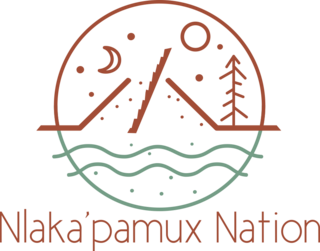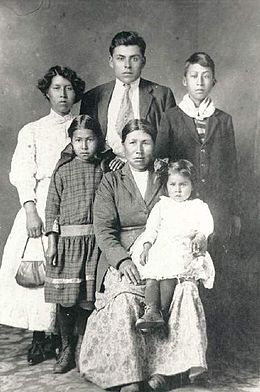
Penticton is a city in the Okanagan Valley of the Southern Interior of British Columbia, Canada, situated between Okanagan and Skaha lakes. In the 2016 Canadian Census, its population was 33,761, while its census agglomeration population was 43,432.

The Okanagan, also called the Okanagan Valley and sometimes the Okanagan Country, is a region in the Canadian province of British Columbia defined by the basin of Okanagan Lake and the Canadian portion of the Okanagan River. It is part of the Okanagan Country, extending into the United States as Okanogan County in north-central Washington. According to the 2016 Canadian census, the region's population is 362,258. The largest populated cities are Kelowna, Penticton, Vernon, and West Kelowna.

The Pend d'Oreille or Pend d'Oreilles, also known as the Kalispel, are Indigenous peoples of the Northwest Plateau. Today many of them live in Montana and eastern Washington of the United States. The Kalispel peoples referred to their primary tribal range as Kaniksu.
The Confederated Tribes of the Colville Reservation is the federally recognized tribe that controls the Colville Indian Reservation, which is located in northeastern Washington, United States. It is the government for its people.

Oliver is a town near the south end of the Okanagan Valley in the Southern Interior of British Columbia, Canada, with a population of nearly 5,000 people. It is located along the Okanagan River by Tuc-el-nuit Lake between Osoyoos and Okanagan Falls, and is labelled as the Wine Capital of Canada by Tourism British Columbia. It was once "The Home of the Cantaloupe" as well as the "Home of the International Horseshow."
The Nicola people are a First Nations political and cultural alliance in the Nicola Country region of the Southern Interior of the Canadian province of British Columbia. They are mostly located in the Nicola River valley around the area of Merritt and are an alliance of Scw'exmx, the local branch of the Nlaka'pamux (Thompson) people, and the Spaxomin, the local branch of the Syilx or Okanagan people. The combined population of the communities composing the Nicola people is approximately 3,492, with around 1,250 of these members living on-reservation.

Boundary-Similkameen is a provincial riding formed in 2008. It includes the populations of Penticton-Okanagan Valley, West Kootenay-Boundary and Yale-Lillooet. The riding's name corresponds to that of a former riding in the same area, with similar but not identical boundaries.

The Regional District of Okanagan-Similkameen (RDOS) is in southern British Columbia, adjacent to the U.S. state of Washington. It is bounded by Fraser Valley Regional District to the west, Thompson-Nicola Regional District and Regional District of Central Okanagan to the north, Regional District of Kootenay Boundary to the east, and by Okanogan County, Washington to the south. At the 2011 census the population was 80,742. The district covers a land area of 10,413.44 square kilometres (4,020.65 sq mi). The administrative offices are in the City of Penticton.

Cawston is an unincorporated small community in the south Similkameen Valley, with a 2005 population of 973.
The Interior Salish languages are one of the two main branches of the Salishan language family, the other being Coast Salish. It can be further divided into Northern and Southern subbranches. The first Interior Salish people encountered by American explorers were the Flathead people.

The Westbank First Nation is a self-governing First Nations band in the Okanagan region of British Columbia, Canada, and is one of eight bands that comprise the Okanagan Nation Alliance of Syilx people. Westbank First Nation (WFN) is governed by one chief and four councillors, elected every three years by WFN membership. As of April 2019, WFN's membership totaled 914 members, and employs more than 200 people.
The Lower Similkameen Indian Band or Lower Smelqmix, is a First Nations band government in the Canadian province of British Columbia. Their office was in the village of Keremeos in the Similkameen region, until 2015 when they moved into their own $7million multi-purpose facility south of Cawston. They are a member of the Okanagan Nation Alliance.
The Upper Nicola Band is a First Nations band government in the Canadian province of British Columbia, located near the town of Merritt in the Nicola Country at Douglas Lake. They are a member of both the Okanagan Nation Alliance and the Scw’exmx Tribal Council, which is a joint government of Okanagan and Nlaka'pamux bands.
The Okanagan Nation Alliance is a First Nations Tribal Council in the Canadian province of British Columbia, spanning the Nicola, Okanagan and Similkameen Districts of the Canadian province of British Columbia and also the Colville Indian Reservation in Washington state of the United States of America. Their territory covers roughly 69,000 km2 in the Canadian Province of British Columbia and also some area of Washington state in the United States of America. The diverse landscape covers deserts, lakes, forests, and grasslands.
Okanagan, or Colville-Okanagan, or Nsyilxcən, is a Salish language which arose among the Indigenous peoples of the southern Interior Plateau region based primarily in the Okanagan River Basin and the Columbia River Basin in precolonial times in Canada and the United States. Following British, American, and Canadian colonization during the 1800s and the subsequent assimilation of all Salishan tribes, the use of Colville-Okanagan declined drastically.
The Nicola Athapaskans, also known as the Nicola people or Stuwix, were an Athabascan people who migrated into the Nicola Country of what is now the Southern Interior of British Columbia from the north a few centuries ago but were slowly reduced in number by constant raiding from peoples from outside the valley, with the survivors, the last of whom lived near Nicola Lake, assimilated to the Scw'exmx-Syilx Nicola people by the end of the 19th century. The term Nicola for them is a misnomer, though a common one used by ethnologists and linguists - it commemorates a famous Okanagan chief who once held sway over the valley and its peoples as well as over the Kamloops Shuswap).
The Similkameen Country, also referred to as the Similkameen Valley or Similkameen District, but generally referred to simply as The Similkameen or more archaically, Similkameen, is a region roughly coinciding with the basin of the river of the same name in the Southern Interior of British Columbia. The term "Similkameen District" also refers to the Similkameen Mining District, a defunct government administrative district, which geographically encompasses the same area, and in more casual terms may also refer to the Similkameen electoral district, which was combined with the Grand Forks-Greenwood riding by the time of the 1966 election. The Similkameen Country has deep historical connections to the Boundary Country and the two are sometimes considered one region, partly as a result of the name of the electoral district. It is also sometimes classed as being part of the Okanagan region, which results from shared regional district and other administrative boundaries and names. The term "Similkameen District" may also historically refer to the Similkameen Division Yale Land District, which also includes Osoyoos and the Boundary Country to Osoyoos' east.
The Colville people, are a Native American people of the Pacific Northwest. The name Colville comes from association with Fort Colville, named after Andrew Colvile of the Hudson's Bay Company. Okanagan: sx̌ʷyʔiɬpx) Earlier, outsiders often called them Scheulpi, Chualpay, or Swhy-ayl-puh; the French traders called them Les Chaudières in reference to Kettle Falls. The neighboring Coeur d'Alene called them Sqhwiyi̱'ɫpmsh and the Spokane knew them as Sxʷyelpetkʷ.
Olalla is an unincorporated settlement in the South Okanagan region of the Southern Interior of British Columbia, Canada, located southwest of Penticton and just north of Keremeos. Kaleden, just northeast beyond Olalla along BC Highway 3A, occupies the pass dividing the Okanagan Valley beyond and the Similkameen Country of which Olalla is a part.

The Nlakaʼpamux or Nlakapamuk, also previously known as the Thompson, Thompson River Salish, Thompson Salish, Thompson River Indians or Thompson River people, and historically as the Klackarpun, Haukamaugh, Knife Indians, and Couteau Indians, are an Indigenous First Nations people of the Interior Salish language group in southern British Columbia. Their traditional territory includes parts of the North Cascades region of Washington.









